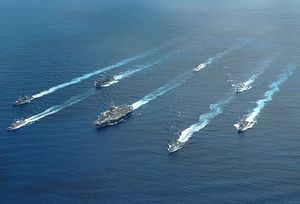Creak. Short-notice, long-distance travel is a great and a terrible thing. My back is reminding me of that, and of some geographic facts. Basic facts, such as: North America is wide; the Pacific Ocean is broad, and largely empty; Asia is tall north to south, its offshore terrain complex and fascinating.
While they appear petite on the world map, moreover, peripheral seas like the South China Sea, an anteroom to both the Pacific and Indian oceans, occupy enormous geographic space in their own right. I changed planes in Hong Kong, along the sea’s northern rim. But another three-and-a-half-hour flight lay ahead before I alighted in Changi Airport, Singapore.
Thirty-six hours, all told, to Singapore from the Naval Diplomat bunker somewhere along the shores of the Narragansett Bay. Big world. It beats me how Robert Kaplan keeps up such a travel schedule year in, year out.
But enough of the geography lesson. As my last column reported, I was summoned to the city-state last week on a hyper-clandestine mission to spread disinformation about ballistic-missile submarines among our Chinese friends. Mission accomplished!!
Tell no one. In all seriousness, our workshop explored how to preserve and defend strategic stability as Asia and the world enter a second nuclear age. This new age is populated by nuclear oldtimers such as the United States, Russia, and France, relative newcomers such as India and Pakistan, and nuclear oldtimers inventing their arsenals anew, such as China.
That portends an end to bipolar, relatively stable, predictable deterrence. A kaleidoscope is a better metaphor. More nuclear-weapon states means more rivals to deter. Some nuclear-weapon states are bulking up and configuring their arsenals. Others are pursuing arms reductions. Virtually invisible, omnipotent SSBN fleets, consequently, represent a big part of second-nuclear-age strategy. Oldtimers have them; newcomers want them.
So far, so good. In the last session, though, an unwary panel chairman asked me to tender my number-one bit of advice for the U.S. government as it strives to manage this brave new world. Here it is: stop separating nuclear strategy from strategy writ large. There is strategy, and there are implements used to execute strategy. Some of these are unconventional, others conventional. It takes a mix of both, coupled with obvious resolve to use them in times of strife, to sustain the alliances that constitute the bedrock of America’s strategic position in Asia.
Letting conventional deployments wilt while keeping nuclear deterrence strong will let Washington deter doomsday scenarios that justify nuclear-weapons use. But rivals can make lots of mischief beneath the nuclear threshold unless faced with powerful conventional counterforce. That’s the lesson of the 1950s, when massive retaliation fended off all-out war but did little to discourage subversion, insurgencies, minor-league military aggression, and other methods deployed by godless communists to expand their sway.
In short, nukes can deter some things — but not the things allies fret about on a day-to-day basis. It’s doubtful U.S. leaders would pull the nuclear trigger over, say, the Senkaku Islands or China’s nine-dashed line in the South China Sea. It takes conventional armies, navies, and air forces to manage such controversies. Yet Asian allies see vital interests at stake in such struggles, even if Americans don’t. If the allies lose faith in U.S. military might, and conclude they cannot field forces strong enough to ward off Russia or China, then they may seek nuclear deterrents of their own. The kaleidoscope turns.
Ergo, if U.S. leaders want to simplify the geometry of deterrence — and keep Asia from descending into brutish, Hobbesian competition of all against all — then they must keep the number of nuclear-weapon states as compact as possible. By sustaining a credible nuclear deterrent in concert with unbeatable conventional forces, Washington can suppress U.S. allies’ incentive to burst through the nuclear barrier. Again: nuclear strategy is indivisible from strategy.
A robust U.S. strategic posture, then, means more than providing nuclear security guarantees to allies such as South Korea and Japan. It means shoring up conventional military power. So to navigate the second nuclear age, let’s revivify the alliance system, and thereby America’s strategic position in Asia.

































